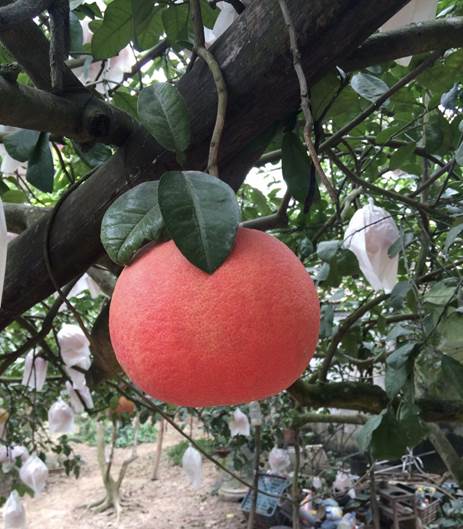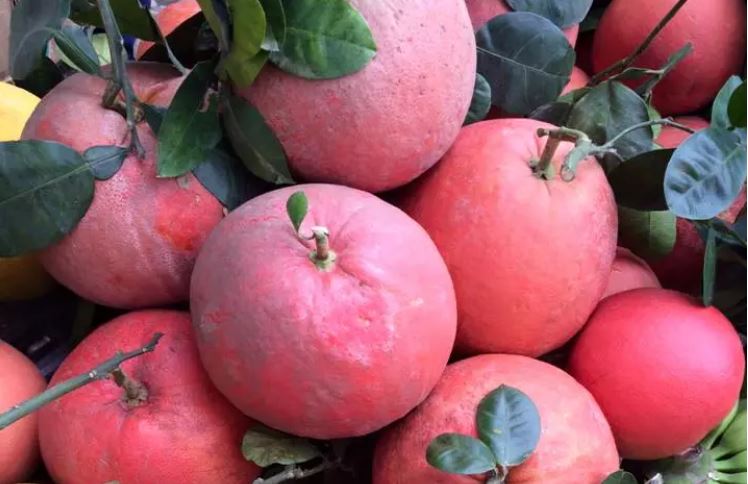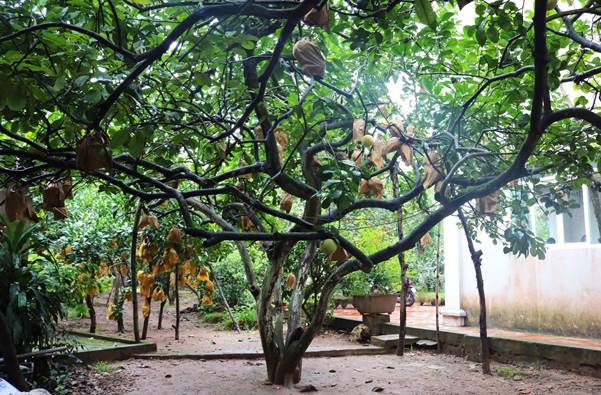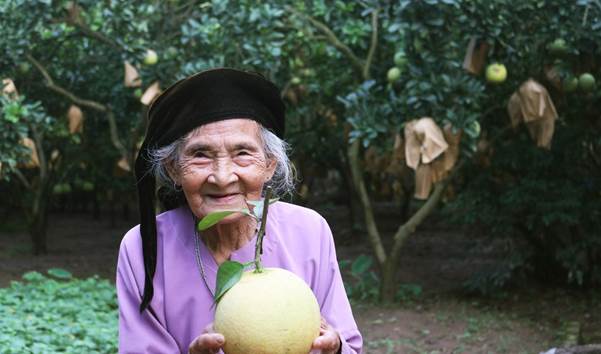Red skin pomelos magically turn from green to yellow over time and then red before Lunar New Year. The trees bear fruit with green skin around the eighth lunar month. Its skin gradually turns yellow in the tenth month and reddish orange like a gac fruit around Tet (Lunar New Year) holiday, which peaks on February 12 this year.

Long-standing specialty
Red skin pomelos that are high in fiber and low in calories, and they contain bioflavonoids and other plant chemicals that protect against serious diseases like cancer, heart disease, and the formation of tumors. Grapefruits increase the body’s metabolic rate, lower insulin levels, and give you a feeling of fullness. They assist the human body in fighting various conditions like fatigue, fever, malaria, diabetes, constipation, indigestion, urinary problems, excess acidity, and many more.
Red skin pomelos were brought to the local area by Mr. Dam Van Tien. When pomelos grew and bore fruit in early August, his family picked up all the grapefruit for sale. But there are a few fruits left on the tree, changing color increasingly red, smooth and eye-catching.
Seeing strange and delicious grapefruit varieties, local people asked Mr. Tien to extract branches to plant. This fruit appeared more and more in Dong Cao village, spread to other villages. At that time, people often compared the value of a grapefruit with a match of rice, because it was fancy and delicious. Until now, Dong Cao red pomelo is still called “fighting rice pomelo”. Red grapefruit usually appears on the five-fruit tray on Tet holiday, or to present or give to relatives and relatives during the holidays.
The historic flood in 1971 in the Red River Delta knocked down some local pomelo roots, making the area of red pomelo narrow. In the late 90s and early 2000s, when agriculture was restructured, the whole peri-urban village switched to planting a number of other crops. The red grapefruit roots are replaced by sapodilla, French roses and vegetables. Until early 2010, Dien pomelo was crowned and red pomelo was almost forgotten, only remaining in a few households.
 |
|
Red skin pomelos – a specialty of the East Cao region. Red skin pomelos are green in growth stage, then turning yellow and ripe fully 100% red like Gac (Momordica cochinchinensis). There are two types of red skin pomelos in Dong Cao village: sweet pomelos and sour pomelos. |
According to Director of Dong Cao Red Pomelo Cooperative, Mr. Luong Van Phuong, who owns 3 top-line pomelo trees extracted from the stump of Mr. Tien, said, in 2014, the Department of Agriculture and Rural Development Ha Noi knew about the rare local variety of red skin pomelos, so he selected the top tree. Mr. Phuong is close by, propagates and develops for neighboring people. Realizing red skin pomelos’ values in life, economy and culture, many households have returned to plant and develop this variety.
 |
|
The first pomelo tree was in 1967 is one of the 250 plants that are currently genetically preserved. |
Red skin pomelos start to be harvested from August to December of the lunar calendar. Those want to buy red skin pomelo must order 2 months in advance. “The 30-40 year old trees produce about 200 fruits a year. This yield falls to 90 – 120 fruits for trees from 10-20 years. Each fruit weighs an average of 0.8 – 1.2 kg, the price is around 80,000 – 90,000 VND, red skin pomelos will cost twice on Tet”, Mr. Phuong said.
Preserving these precious red skin pomelos
In January 2019, Dong Cao Red Skin Pomelo Cooperative was born with the aim of preserving genes and maintaining red skin pomelo varieties, and at the same time developing commercial businesses for households. According to statistics of the Commune People’s Committee, at present, the cooperative has 20 households growing red pomelo with about 2,500 trees, spread in 4 administrative areas, of which concentrated in hamlet 3, Dong Cao village.
In addition to favorable climatic conditions, soil and long-standing seed sources, people focus on improving soil, improving techniques and keeping genetic resources, enhancing the dominance of red skin pomelos.
 |
|
Red skin pomelos are the pride of Dong Cao people. |
Households have changed the model of growing red skin pomelos from conventional, inorganic to organic farming such as sprinkle lime powder, organic fertilizer to reduce soil alum, clean water for pomelo trees, carry fruit bag when maturing to achieve high quality and productivity, extending the harvest time to the Lunar New Year.
Currently, red skin pomelos have been propagated in some provinces such as Yen Bai, Son La, Lang Son and some southern provinces such as Vinh Long, An Giang – Vietnam.
According to the red pomelo variety development project, by 2023, Me Linh district has a total of 100,000 trees, by 2030 the locality has a specific pomelo region and towards a clean agriculture combined with eco-tourism. At the same time, the cooperative also cherishes the dream of exporting red pomelo varieties with unique designs and high quality to Japan.
According to The Healthsite, a red skin pomelo is the citrus fruit with the most lycopene at 3.6 – 34 mcg / g weight. This is a compound that plays an important role in the process of creating red, yellow or orange pigments. Lycopene is a powerful antioxidant, which is used to prevent cancer and cardiovascular disease. The Japanese call this compound “warrior” because of its ability to prevent aging, fight free radicals, and make skin ruddy, healthy.
Red Skin Pomelos













